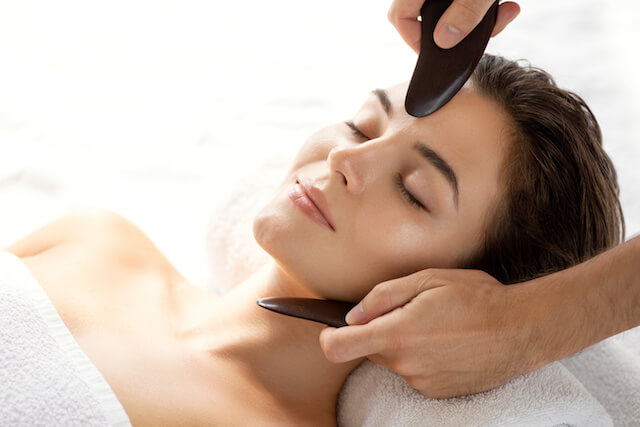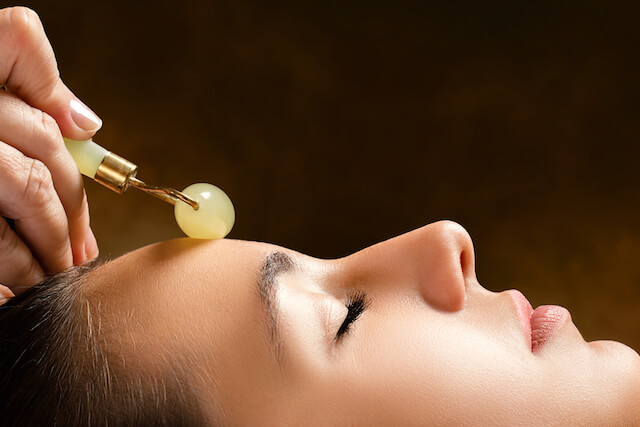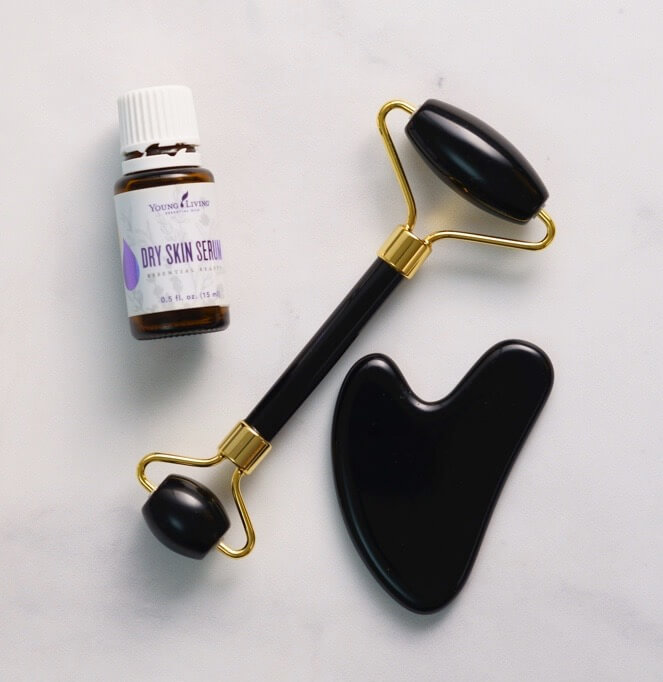I recently shared on Instagram about my favorite obsidian face roller and gua sha plate (that I call my neck carver-outer). These two alternative skincare therapies have changed my daily routine and are keys to keeping my skin youthful and vibrant. They help me combat wind, pollution, dehydration, and other elements that are so hard on the delicate skin of the face.
What is Gua Sha?
Gua sha is an ancient Traditional Chinese Medicine (TCM) treatment. The process involves using a smooth-edged massage tool to scrape and rub parts of the skin repeatedly in one direction.
Gua sha aims to address stagnant energy, called chi, in the body. Releasing negative energy may help reduce inflammation. The primary aim is to break up the chi and activate blood circulation. Additionally, the technique breaks up fascia and improves skin tone.
In TCM, practitioners use gua sha treatments to treat certain degenerative diseases. Patients report relief of migraines, neck, shoulder, and back pain, menstrual disorders, insomnia, hypertension, vertigo, chronic infections, sciatica, and arthritis.
Several studies show the benefit of using gua sha to increase microcirculation, thereby relieving pain. Another study documents that gua sha increased immune active cells in the skin tissue.

Facial Gua Sha
Facial gua sha is designed to relieve tension in the muscles of the face, boost blood circulation, and encourage lymphatic drainage. The repetitive scraping motion breaks up fascia to improve circulation. This results in a reduction in bloating, headaches, and jaw pain, with the added benefits of tighter, smoother, and brighter skin. Long-term users even report its ability to unkink folds in the skin and sculpt areas such as the neck.
How it is Performed
Gua sha is best performed on clean skin. First, apply a good quality massage oil to the area you will be working. Angle the gua sha tool so that it is close to parallel with your skin, and then gently sweep up and outward on your face. At the end of each stroke, you can gently wiggle the tool to help release tension. Repeat each stroke three times. You can gradually work up to longer strokes with firmer pressure. If you begin to see red bumps or a rash on the surface of the skin, this is a sign that you are doing it correctly. The rash, known as sha, indicates a release of toxins from the skin. Not everyone will experience a rash or redness though.
The key is to start light and gradually increase according to your tolerance. If you are too heavy-handed, bruising and burst capillaries can result.
Face Rolling
Like gua sha, face rolling is an ancient Chinese practice. The process involves using a facial roller made from various stones to roll around the skin of the face.
Benefits of the Face Roller
Users say face rolling helps reduce inflammation and puffiness, smooths fine lines, increases blood circulation, and eases pain. There is little scientific evidence to substantiate most of these claims. However, there is some information to indicate that it is effective at moving lymphatic fluid, thus reducing inflammation and puffiness.
According to users, one of the key benefits is that it feels amazing. Think of it as a daily face massage. It helps moisturizers and serums penetrate deeply into the skin, while reducing puffiness and redness. Most rollers are made of jade, quartz, or another stone. They serve as a pretty reminder to spend just a few minutes pampering yourself.

How it is Performed
The process is simple. Clean and moisturize your face. I love using a beauty serum with my roller, and I use a more intensive moisturizer or serum in the winter when my skin is more dry. You can just roll the device around your face, focusing on problem areas. If you prefer a routine, the following works well:
- Jawline: Using light pressure, start at the chin, and roll horizontally out to your hairline.
- Nose: Next, roll from the sides of the nose out towards the ears.
- Eyes: Using the smaller end of the jade roller roll from the inner corner of each eye out toward the temple.
- Eyebrows: Roll across the eyebrows, from bridge of nose to temples.
- Forehead: Start at the top of the eyebrows and roll up to the hairline, moving across the forehead. Finish by rolling from the middle of the forehead out towards the temples.

Tried it or want to try it?
Have you tried gua sha or face rolling? Comment and share your insights.
If you are ready to give it a go, click here to order a jade gua sha massager and rose quartz face roller.
Looking for more natural ways to enhance your beauty routine? Check out this post about the Face Blaster.
For access to the entire essential oil encyclopedia, come on and


